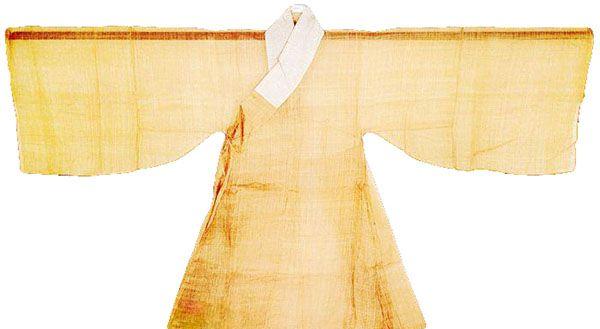It is now the last glory of midsummer
In ancient times, in the sweltering heat
People would wear a garment made of Gebu from Leizhou
Also commonly known as "Shabu"

▲ Ming Ge Sha Dao robe
Leizhou Gebu during the Eastern Han Dynasty
It was listed as a tribute to the royal family
At that time, he had a set of clothes made of Leizhou Gebu
It is a symbol of high social status
Now, Leizhou Gebu making skills
It has been an intangible cultural heritage project in Zhanjiang
Take a look at it with the release jun
How to make Leizhou Gebu
▼
Winter Grebe, Summer Gebu
01
The ancient forests of the Leizhou Peninsula are dense, and there are many plant fibers for clothing. It is particularly rich in various vines, such as perennial vines, also known as kudzu and kudzu, and the fabric made of its fibers is called kudzu, which used to be a precious cloth with the same name as xiangyun yarn.
▲The staff is collecting ge.
According to the literature, in the Shang and Zhou Dynasties, the ancestors of Leizhou had learned the art of making clothes, and the local Kudzu cloth was rich in kudzu, and the finely woven Gebu was better than the silk satin in quality, as thin as a cicada wing, and weighed only a few baht. This cloth is thin and cool, and should be used as a summer coat.
Leizhou Gebu "a hundred dollars a foot"
It was a royal tribute
02
During the Eastern Han Dynasty, Leizhou Gebu was already famous throughout the country, and Leizhou Gebu was "a hundred dollars a foot, smooth and firm, and the color was like blood teeth." ...... Therefore, rege is prevalent in the world", the Central Plains Royal Family constantly sent people to ask for it. Leizhou Gebu also accompanied ancient porcelain and handicrafts, along the coast on the Silk Road, exported to foreign countries.
▲ Leizhou Gebu.
In the Ming and Qing dynasties, the production and trade of Gebu on the Leizhou Peninsula developed. The Gebu produced by various townships and societies gathered in Leicheng and exported to the outside world through Leizhou Port. Leizhou was the production base of Gebu in China at that time. Leizhou Gebu was the most fashionable item in ancient times, and it was also the most precious gift.
In the Qing Dynasty, provincial governors or governors were required to present gifts to the emperor every year on major holidays or at the end of the year. Among the tributes of the Guangdong Inspector Duanyang Festival, there are fifty horses of Leizhou Gebu.
"Disappeared" Leizhou Gebu
03
With a long history, why has the once-famous Leizhou Gebu disappeared now?
The reason for this is that after the Republic of China, due to the impact of the silk and cotton textile industry, coupled with its own production process, low production efficiency, high cost and other factors, the production of Leizhou Gebu almost all stopped.
▲ The raw material for spinning Leizhou Gebu - GeSi.
The weaving artists of Leizhou Gebu have been old enough to collect gebu and weave, resulting in a serious fault of Leizhou gebu weaving artists. Since then, Reger has gradually faded out of the stage of history.
Leizhou Gebu "comes alive" again
04
Foot Rong Village Handmade Museum - the largest rural handicraft museum in the country, you can see the figure of Leizhou Gebu.
According to the staff of the Ashikaga Village Handmade Museum, Miss Xiong:
In 2019, Leizhou Gebu has successfully applied for Zhanjiang Intangible Cultural Heritage. There are more than ten processes of Leizhou gebu, including picking kudzu, breaking kudzu, dipping kudzu, peeling kudzu, boiling kudzu, washing kudzu, tearing kudzu silk, connecting kudzu silk, and winding warp threads, pulling warp threads, wearing buckles, closing threads, brushing threads, making tassels, weaving, etc.
▲Leizhou Gebu spinning.
The dyeing and weaving raw materials of Leizhou Gebu are mainly based on natural plant dyes, mainly through the golden yellow color of the fruit of the yellow branches; the dark red color of the fruit of the grained mutton (local name), the blue color is selected qingdai, and the brown is made of hammer.
Due to the cumbersome process of Leizhou Gebu weaving, the whole process can only be made by hand, and no machine can replace any link.
Coupled with the fact that there are very few weaving artists, for the inheritance and development of Leizhou Gebu, we specially exhibited it in the Zuei Village Handmade Museum, not only to let more people know about Leizhou Gebu, but also to experience the weaving process on the spot and learn more about Leizhou Gebu.
▲ Leizhou Gebu displayed in the Maode GongdaGuan Garden.
Leizhou Geyi, who was once a royal tribute
Not many people know about it today
In the future, I hope that more and more people will know about it
It is also necessary to pass on the skills of Leizhou Geyi
Let Zhanjiang's traditional skills "come alive"
Source: Zhanjiang Release